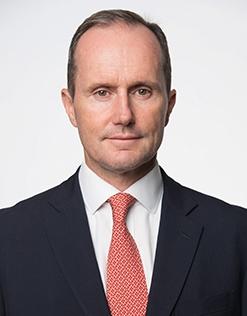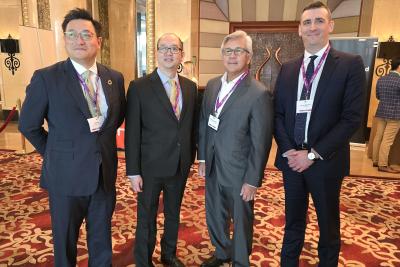GAM’s Rob Mumford on the Compelling Outlook for Emerging Market Equities

Rob Mumford of GAM Investments
Jun 12, 2019
Rob Mumford, Portfolio Manager, Emerging Markets Equities at Zurich-headquartered, global asset management firm GAM Investments is a keen watcher of the Asian emerging markets, including the pivotal role now occupied by China in the regional, as well as the global growth story. He presented to delegates at the Hubbis Philippines Wealth Management Forum, telling them why he and his team firmly believe selected EM equities, especially Asia, will strongly outperform in the next several years.
Mumford began by explaining that he would present his talk in four segments, starting with the risk-reward dynamics of emerging markets, which have significantly underperformed over the last 10 years. Then he would talk about valuations, which he noted remain at discounts to the developed markets (DM) arena despite higher growth rates. He would then cover liquidity flows, and said he expects higher demand for EM assets, both debt and equity. And he would close with structural themes, explaining that the EM scenario offers a compelling structural positives and attractions, compared to the DM universe
A big turnaround
“The conclusion of all this,” he reported, “particularly driven by the relative growth is that on a base case scenario we see returns in equities around 50% to 60% over the next three to four years. On a positive scenario, we see emerging market equities doubling over the next three to four years. From a personal perspective, I am over 50% allocated to the EM equities.”
Mumford then quickly reviewed the covered some of the negatives, including the US-China trade dispute, high levels of debt, negative demographics, low growth, inverted yield curves, very low and in some geographies negative interest rates. “These are all drivers and symptoms of a very growth challenged world in which is it going to be more difficult for investors to generate above-average returns. But if you think about emerging markets, however, the growth opportunity is much better and hence the potential for returns will be higher.”
He added that other negatives include disinflation and financialisation brought about by the new sharing economy, which is technology driven, with very low capital intensity, resulting in a much higher propensity to save and not invest. “The Chinese gaming company Tencent just reported it generated USD4 billion in free cash flow in its latest 1Q results. These and others large technology companies are not investing to the same degree as old economy industries, instead generating large amounts of cash, which is suppressing economic growth rates.”
EM’s growth dynamics shine
But contrast that to the broader EM arena, he said. “The Philippines is a great example,” with exceptional demographics in terms of the young population, good education, English speaking, low levels of debt. GDP forecast at around 6% for the next few years, there is inflation but contained. The current account deficit is moderate. This is an example of why the growth opportunity in emerging markets such as the Philippines is much higher. Converting savings to investments in such markets is a huge opportunity for economic growth going forward.”
He turned to valuations. “Looking at the PE multiple, the EM arena trades at quite a big discount to DM stocks. But countries such as the Philippines or China at the moment are offering mid-teen earnings growth. Accordingly, we can extrapolate that one of two things are going to happen - either the market continues to be de-rated and look increasingly appealing in a low yield world, or you get this double-digit earnings growth turning into returns, and at the same time you might get a positive re-rating for those premium growth rates. We believe it is this latter, positive scenario that will prevail, and the result is the returns I talked about, namely 50-60% or more over a three- to four-year period.”
A hefty discount, despite better growth
Mumford noted that the US market at a PE of about 17 times and China at roughly 11, similar to the EM indices in general, means there is a disconnect. “Growth in the EM economies is better, yet valuations are cheaper,” he observed, “but we also need to consider how capital flows react to that. What we saw during the extended QE phase is that risk aversion remained high and slower developed economy growth led to slower EM growth particularly for the export-orientated markets, leading to under-performance.”
However, he explained that since 2016-17 the relative EM economic growth has started to re-accelerated and together with a shift to quantitative tightening or at least neutrality, we would expect portfolio flows to trend back to EM, thereby reversing the underperformance of recent years.
A stronger dollar and idiosyncratic situations including in smaller markets like Turkey and Argentina do present risks. However given the valuations on offer in terms of earnings yields and dividend yields plus diversification benefit presents an attractive risk reward proposition. As far as a normalising cycle and higher US rates driving a potentially stronger US Dollar are concerned, it is interesting to note EM tends to outperform after the initial phase of rate rises
Structural positives
Mumford then moved on to the structural argument in favour of EM. “I have been lucky enough to cover the Asian markets, including the Philippines, for the last 20 years. Back in the 90s, only four of the top 10 EM economies were investment grade, and today, it is 8 of the 10.”
“So,” he added, “we have discounted valuations, higher growth, significant liquidity support, and the additional structural integrity of stable, investment grade economies. Emerging markets represent 60% of the world population, 40% of world GDP but a mere 10% of global market capitalisation within MSCI (in terms of free float). This will not remain the case”.
GAM: Swiss heritage, global coverage
Mumford also briefly introduced GAM to any in the room who were not familiar with the firm. “We are an independent global asset management firm built by investors, for investors,” Mumford explained. “We excel by focusing on truly active management of differentiated investment strategies.”
GAM Investments describes itself as an independent, pure-play asset management group and is headquartered in Zurich. The group sells to a wide range of client segments such as institutions, wholesale intermediaries, financial advisers, and private investors. AUM stands at CHF137.4 billion, and the firm has more than 900 staff in 14 offices around the world. Some CHF55 billion is in client asset management, while CHF82 billion roughly is in private labelling solutions, such as management company and other support services, to third parties.
With a 35-year heritage, GAM invests clients’ capital using active strategies across discretionary, systematic and specialist solutions. “As our industry evolves, we develop new products with global appeal and attractive returns to access new pools of client assets and to adapt to our clients’ changing needs,” Mumford added.
“I am part of a team that run an emerging market equity fund with AUM of about USD1 billion. GAM also offer private label solutions where clients can package whatever products they want, which is particularly relevant in this day and age of low growth in which we are all going to have to be a lot smarter about how we invest.”
And to achieve that type of smarter performance, Mumford clearly believes EM is the place to be. “For all the reasons I have explained today,” he concluded, “the EM equity and debt markets will change, for the better, so it is simply when and not if this happens. Investors like you here today and your clients should, like me, be overweight in this space.”

Portfolio Manager, Emerging Markets Equities at GAM Investments
More from Rob Mumford, GAM Investments
Latest Articles






